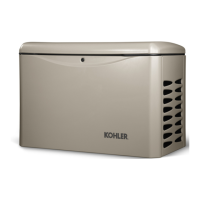
Do you have a question about the Kohler 26RCA and is the answer not in the manual?
| Type | Portable Generator |
|---|---|
| Starting System | Recoil |
| Rated Output (Watts/kW) | 2600 Watts / 2.6 kW |
| Peak Output (Watts) | 3250 Watts |
| Noise Level (dBA) | 68 dBA |
| Rated AC Voltage (Volts) | 120 Volts |
| Rated AC Frequency (Hertz) | 60 Hz |
| Phase | Single |
Guidance on preventing unintended generator set startup to avoid severe injury or death.
Details on ensuring exhaust system integrity and preventing carbon monoxide hazards.
Information regarding potential hearing damage from generator noise and protective measures.
Warning about hot engine and exhaust system components and safety precautions.
Process for registering the generator set and obtaining an unlock code for AUTO mode.
Overview of installation requirements and safety considerations for generator set location.
Instructions and warnings for safely lifting and moving the generator set using proper equipment.
Procedure for thoroughly inspecting the generator set for any loose or damaged parts before installation.
Guidelines for selecting an outdoor location and preparing the mounting area for the generator set.
Reference to drawings detailing generator set dimensions, clearances, and inlet locations.
Procedure for removing enclosure panels to access internal components like the battery and electrical connections.
Details on fuel types (natural gas, LPG) and required fuel supply pressure and flow rates.
Recommendations for selecting appropriate fuel pipe sizes based on length and fuel type.
Procedure for connecting the fuel supply line to the generator set, including sealant and flexible sections.
Information on converting the generator set between natural gas and LPG fuel types.
Steps to convert the 14RCA/L model between natural gas and LPG using orifice fittings.
Steps to convert the 20RCA/L model between natural gas and LPG using orifice fittings.
Procedure for fuel conversion using a knob on the regulator for revised fuel systems.
Instructions for making electrical connections, including grounding and AC power supply requirements.
Guidelines for selecting appropriate wire temperature ratings and types based on circuit requirements.
Requirements and methods for properly grounding the generator set in compliance with codes.
Locations and methods for drilling holes for electrical conduit entry into the generator enclosure.
Procedure for connecting the generator set to external loads, transfer switches, and accessories.
Requirements for connecting AC power for the battery charger and optional accessories, ensuring generator backup.
Safety precautions, description, and installation procedures for the generator set battery.
Details on connecting automatic transfer switches and RBUS accessories to the generator set.
Specifications for communication cables used with transfer switches and RBUS accessories, including length limits.
Procedure for connecting Model RXT transfer switches and remote start/stop switches to the generator set.
Guidance on connecting various accessory modules like APM, PIM, and load shed kits to the generator set.
Checklist of critical items to verify before starting the generator set for the first time after installation.
Instructions for setting the generator set's automatic exercise schedule for weekly, bi-weekly, or monthly operation.
Overview of available accessories for generator sets and general installation recommendations.
Information on the carburetor heater for improved cold starting, including thermostat settings and power requirements.
Details on the PIM for programmable inputs and dry contact outputs, including its configuration and connection.
System for monitoring and controlling the generator set remotely via computer, smartphone, or tablet.
Description of optional devices for managing electrical loads, including load shed kits and interface boards.
Description of the power relay module kit for load management, including its specifications and connections.
Details on the APM for paralleling two generator sets, including features and compatible combinations.
Recommendations and kits for reliable operation at temperatures below 0°C (32°F).
Information on optional battery heater kits for improved cold weather performance, including specifications.
Details on kits to improve cold starting by heating the breather tube and oil.
Information on the fuel regulator heater for improved cold starting in extreme cold, requiring continuous AC power.
Details on the alternator weather cover used to prevent frost and snow buildup on brushes.
Function and installation of the oil pressure sensor boot to protect against moisture and frost.